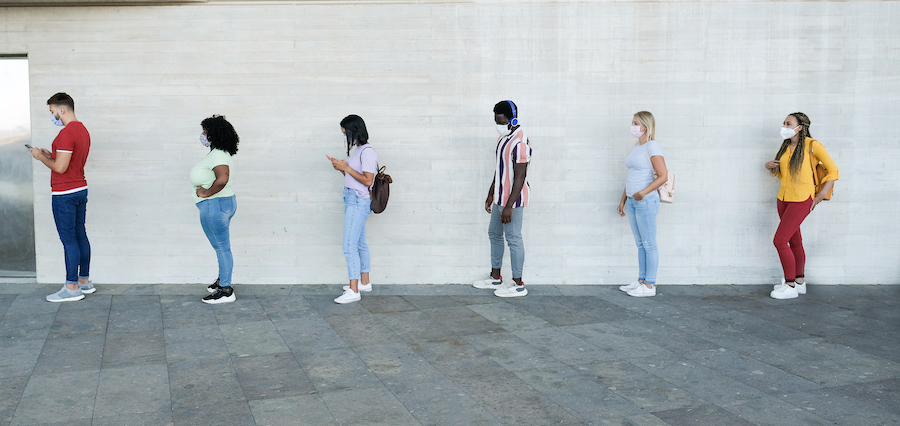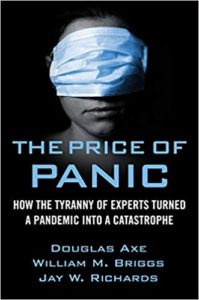Is the Six-Foot Rule Based on Solid Science?

Joe Biden keeps claiming that he, in contrast to the president, will follow “the science” and “listen to the scientists.” But little of the hygiene theater we’ve had to perform for the past eight months enjoys clear scientific support.
Take the six-foot rule, which we’ve all had drummed into our muscle memory. Avoiding other people is now treated as a mercy rather than misanthropy. We’ve been told it’s just the right distance to keep us from spreading the coronavirus to our neighbors. But is this rule based on science? Not really. If anything, recent evidence undermines it.
How Viruses Spread
Experts agree that we can pass the flu virus to others either by contact (as when snotty hands touch a handrail, which is touched by other hands), by droplets (spray from a cough) or by aerosol (microscopic mist from coughs, sneezes, or speech). We know that aerosol particles can stay suspended in air for hours and small droplets for minutes.
Yet for years, public health officials have downplayed airborne transmission. A WHO document, for instance, describes how larger droplets are “assumed to be the main mode of transmission for influenza.” That’s a key assumption, since the six-foot separation rule hinges on it.
What About Aerosols?
Six feet has merit for avoiding big droplets. But it provides a false security if smaller droplets and aerosols play a large role in passing a virus, as many studies have indicated.
That applies to the coronavirus as much as to the flu. A study published in April showed that the new coronavirus, like the earlier SARS-CoV-1, hangs in the air for over an hour in aerosol form. Researchers have now detected virus particles, by the millions, in the exhaled breath of COVID-19 patients. These airborne particles have been shown to be infectious, though sunlight reduces that. And virus from hospitalized patients has been detected in the air fifteen feet away. These results add up to make airborne transmission a major mode of infection—maybe the main one.
The CDC has a long history of downplaying the role of aerosol transmission for respiratory viruses. But the agency, faced with mounting evidence, has just relented. It now acknowledges that “airborne transmission of SARS-CoV-2 can occur under special circumstances.” This is careful rephrasing of language that stirred commotion after it appeared on their website on September 18.
If we really look at the evidence from science, the six-foot rule is cold comfort.
Nevertheless, it marks a major shift. In the past, “special circumstances” meant risky procedures, like intubation. But in the current guidelines it includes the sharing of “enclosed spaces.” Think hallways, rooms, and vehicles—circumstances that are anything but “special.”
Six feet of separation, then, does little to guard against transmission by tiny aerosol particles.
No Magic Distance
Even for protection against large droplets, the recommended distance varies. WHO said one meter, or about three feet, a number the CDC agreed with because of SARS research. Taiwan went with 1.5 meters, as one of us can attest from living there during the pandemic. A U.S. Army Colonel and chief of Preventive Medicine Services, Public Health Command Europe, said, “I recommend you stay 12 feet apart.” Some scientists in the UK complained that the two-meter rule (about 6.5 feet) adopted there was based on “very fragile evidence.”
So, if we really look at the evidence from science, the six-foot rule is cold comfort. If you walk through a grocery aisle where an infected man was gabbing a minute or two earlier, you’ll probably inhale small droplets or aerosol particles he left behind. Outdoors, where even a gentle breeze quickly sweeps aerosols away, your odds are much better. That fits with a recent report that coronavirus transmission to multiple people almost always happens indoors.
It’s common sense that the farther apart people are, the less likely they are to pass an infection to each other. But the six-foot rule, like so many of our efforts to stop the coronavirus, turns out to be more hygiene theater than solid science.
Doug Axe, William Briggs, and Jay W. Richards are the authors of The Price of Panic: How the Tyranny of Experts Turned a Pandemic into a Catastrophe.


